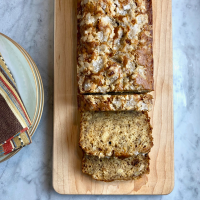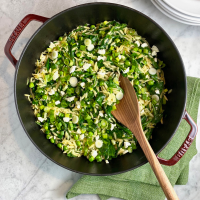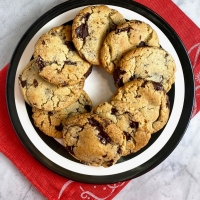
I love a festive holiday meal. We ate this “lighter” version of a classic shepherd’s pie for our St. Patrick’s Day dinner with soda bread and roasted asparagus. My husband described it as a delicious blend of meatloaf and chicken pot pie. 🙂
The recipe was adapted from today.com, contributed by Kelly Vaughan. I modified the method and proportions. I loved the wine and the herbs in the filling. It was saucy and tasty.
Yield: Serves 6
- 1 pound russet potatoes, peeled and halved (I used 2 potatoes)
- 1/2 cup heavy cream or half and half, plus more as needed
- 5 T unsalted butter, divided
- 2 tsp Kosher salt, divided, plus more to taste
- 1 tsp freshly ground black pepper, divided, plus more to taste
- 2 T neutral oil, divided (I used canola oil)
- 1 pound 93% lean ground turkey
- 1 large yellow onion, diced
- 2 large carrots, diced
- 2 celery sticks, diced
- 6 large garlic cloves, minced
- 2 tsp chopped fresh thyme
- 2 tsp chopped fresh rosemary
- 2 tsp chopped fresh sage
- 1 T tomato paste
- 1/2 cup dry white wine
- 1 cup chicken stock
- 1 T all-purpose flour
- 1 cup frozen peas
- Preheat the oven to 400 F, preferably on convection.
- Make the topping: In a medium pot, add the potatoes and cover with 1-inch cold water. Bring to a boil over high heat, then reduce the heat to medium and continue to cook until the potatoes are fork-tender, about 22 minutes.
- Heat the cream and 4 tablespoons of butter in a small saucepan over low heat, stirring occasionally to prevent scorching.
- Add 1 teaspoon salt and 1/2 teaspoon of pepper to the cream and butter. Stir to combine.
- Drain the potatoes in a colander.
- Press the cooked potatoes through a potato ricer into the pot containing the seasoned cream and butter. Stir to combine. Set aside.
- Make the Filling: In a large straight-sided skillet set over medium-high heat, add 1 tablespoon oil and heat until shimmering. (I used a stainless sauté pan.)
- Add the ground turkey and 1 teaspoon kosher salt and 1/2 teaspoon pepper. Cook, breaking up the meat with a spoon, until browned, 7 to 9 minutes.
- Using a slotted spoon, transfer the meat from the skillet to a bowl and set aside.
- Add 1 tablespoon of oil and heat until shimmering. Add the onion, carrots and celery, and sauté until softened and translucent, 8 to 10 minutes.
- Add the garlic, thyme, rosemary, and sage, and cook for about 1 minute.
- Add the turkey back to the skillet and stir to combine.
- Add the tomato paste and stir to combine.
- Lower the heat to medium-low, add the white wine and cook for about 2 minutes, stirring occasionally.
- Add the chicken stock and 1 tablespoon butter, and cook, stirring to combine, about 1 minute.
- Add flour and stir to combine, bring to a simmer and mix until the liquid has slightly thickened.
- Add the peas and cook, about 2 minutes.
- Taste and season with salt and pepper.
- Transfer the turkey mixture to a 2-quart oval baking dish and spread in an even layer. Top with mashed potatoes and spread evenly to cover the filling.
- Bake for 20 minutes on convection or up to 25 minutes in a standard oven.
- Broil on high for an additional 3 to 5 minutes, until the potatoes begin to brown. Serve immediately.





















